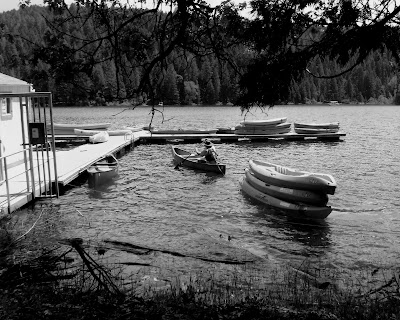"A lake is the landscape's most beautiful and expressive feature. It is Earth's eye; looking into which the beholder measures the depth of his own nature." - Henry David Thoreau
It's a right turn. Another right after a block. Then down the hill and across the bridge. To my right, is the river, to my left is the lake. A left turn towards the park entrance and through the gate. A wave to the park attendant gate and then turn left into the parking lot. The kayak comes off the roof and slides into the water.
I'm on the lake now and paddling hard to cross it. Only a little further to go as I round the bend into quiet waters. My kayak whisperers as I glide through the culvert under the bike trail. I'm there now. My own personal Walden.
Walden or Life in the Woods written by philosopher and naturalist Henry David Thoreau, in 1854, is a reflection upon living simply in nature's surroundings. Thoreau detailed his daily experiences over the course of two years, two months, and two days in a cabin he built near Walden Pond in the woods owned by his friend and mentor, Ralph Waldo Emerson near Concord, Massachusetts.
"In such a day, in September or October, Walden is a perfect forest mirror, set round with stones as precious to my eye as if fewer or rarer. Nothing so fair, so pure, and at the same time so large, as a lake, perchance, lies on the surface of the earth. Sky water. It needs no fence. Nations come and go without defiling it. It is a mirror which no stone can crack, whose quicksilver will never wear off, whose gilding Nature continually repairs; no storms, no dust, can dim its surface ever fresh; — a mirror in which all impurity presented to it sinks, swept and dusted by the sun's hazy brush — this the light dust-cloth — which retains no breath that is breathed on it, but sends its own to float as clouds high above its surface, and be reflected in its bosom still." -Henry David Thoreau
Some 160 years later, I find this same peace and solitude paddling in the sloughs of Lake Natoma. There is only one way in and one way out. No rush after that. Only a watery path meandering through little islands that geese, ducks, and frogs call home. Along the way, I hear the plop of turtles falling off the dead logs into the water. I can see them for only moments before they slip under the dark water. I'm just a little too close, I suppose.
There is a touch of color along the banks. Bright reds and dull yellows in the trees give notice that it is autumn in northern California. Blackberry bushes line the water's edge. Weeks ago they were full of ripe berries, but they are mostly gone now. Up and away, towards the end of the slough, cattails take over the view. Ducks and deer are common here. The deer stand motionless hoping not to be seen before escaping into the woods, while the ducks swim about used to visitors.
The kayak makes little sound gliding through the water. My paddle slides in and out methodically. There is no hurry at my Walden.





































